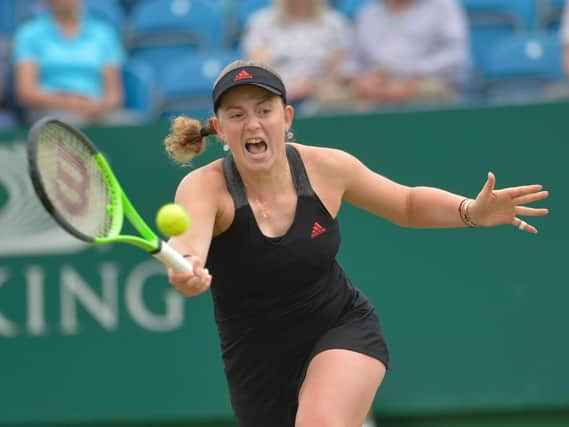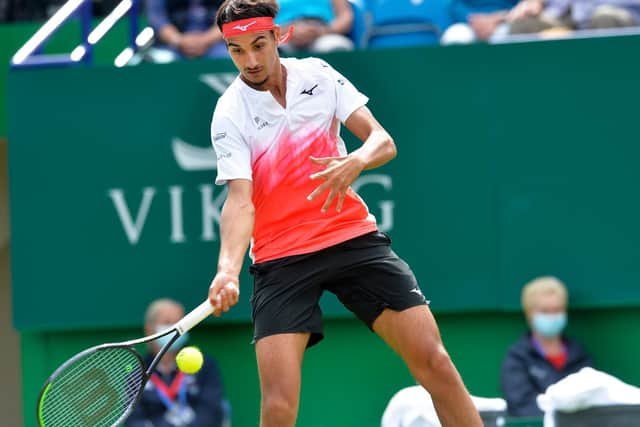Eastbourne tennis week saved the best 'til last


Quarter-finals, in any sporting competition, have a special quality. To progress this far, all the combatants must be in good form, and building their confidence and their sharpness with each match. The prize of the final is not quite in touching distance – but in the last eight, the players are not burdened with that wretched fear of failure at the last fence.
And the line-ups, in both women’s and men’s competitions, were all the more intriguing because no player really carried a favourite’s tag. All were in the quarters on merit, and more than one player had been battling through since the qualifying rounds began last Saturday.
Advertisement
Hide AdAdvertisement
Hide AdNow 27 but still looking 19, Camilla Giorgi has been around the circuit for a while. But appearances can deceive. The trim, compact figure who steps quietly on to the enormous amphitheatre of Centre Court is the antithesis of some of today’s tall, muscled athletes. Even her outfits have a dainty classic cut.


Giorgi’s play is focused, accurate, relatively simple. No outrageous shots or improvisation. Not a lot of risk. But goodness, she hits the ball hard. Over the net from her, the imposing figure of top seed Aryna Sabalenka. At a glance, the two could hardly have been less evenly matched for physique, but against the odds it was the Italian who came through. Her unforced-error count of almost nil contrasted with the energetic but frustrated Sabalenka – and so out went the top seed.
And so the semi-final line-ups were falling into place. Giorgi would face Anett Kontaveit, the intelligent and composed Estonian, while Latvian Jelena Ostapenko would take on Daria Kasatkina. Not the best known of the 64 ladies who started the tournament, but a quartet of quality. Of course, if you had read last week’s Eastbourne Herald, you’d not have been at all surprised: we had picked out Ostapenko, Kontaveit and Kasatkina as our three players to follow through the week.
Advertisement
Hide AdAdvertisement
Hide AdIt is only honest to add that your Herald reporter had not even attempted to filter out four men for the semi-finals – the field was simply wide open. Nobody who had watched Alex De Minaur during the week was surprised to see the athletic Australian scything through the rounds. It’s almost a rite of passage, isn't it, for 23-year-old Aussies to backpack across the world – but Alex slipped a tennis racquet into his backpack too.
From the other half of the men’s draw, Italian Lorenzo Sonego had been unstoppable, and in Friday’s semi-finals both he and De Minaur blazed their opponents aside to set up what, on Saturday, would produce the best Eastbourne men’s final ever.
Giorgi’s dazzling week, though, had come to a sudden halt in her semi-final. At 5-5 in the first set, with a heavily strapped thigh, she retired, and Kontaveit was through to the final. In the other semi, Ostapenko and Kasatkina might have been twins – similar build, playing style and even identical sombre black outfits.
One of the aspects that stands out, in a tournament like this, is a sort of United Nations of Tennis. Sport unites. If polite Herald readers will permit my bluntness: racism stinks. If it wasn’t so offensive, it would be laughable. You might as well shun your next-door neighbour for driving a Japanese car, or cold-shoulder a work colleague for being left-handed.
Advertisement
Hide AdAdvertisement
Hide AdEven from a distance, it is clear that players enjoy great friendships right across all nationalities, ethnic groups, or even tastes in food or music bands! In sport, you can be black, white or purple as long as you are a good team-mate or a generous opponent, and a decent human being. Racism lurks ever lower in our world, but sporting ideals climb higher.
Anyway, the right sort of national pride and rivalry would now hallmark the Eastbourne week. Little Latvia’s Jelena steadily tightened her grip and squeezed out mighty Russia’s no 1 Kasatkina, to set up a Battle of the Baltic women’s final.
Latvia versus Estonia – is that a Baltic equivalent of England against Scotland? Not quite so fierce! The two are courteous and genial neighbours, and these two young ladies are good friends. Under a low grey Eastbourne sky, the Centre Court watched as Ostapenko raced ahead early, to leave Anett Kontaveit always scrambling to catch up. The crowd would have loved a deciding third set, but a single break clinched the second set, and the title, for Jelena Ostapenko.
But an admirable, enjoyable women’s final was about to be upstaged by the guys. De Minaur and Sonego conjured up an absolute feast of tennis, high-octane and high-quality. Sonego, lofty as a ladder and lithe as a prowling tiger, paced the back court and chattered to himself in Italian. Alex De Minaur stretched for impossible returns, gambled on unlikely angles and turned desperate defence into winning shots.
Advertisement
Hide AdAdvertisement
Hide AdThis one, to the crowd’s delight, did go to a third set – and then to an achingly tight tie-break, before De Minaur clinched the title. The Viking International had saved the very best match until the very last.